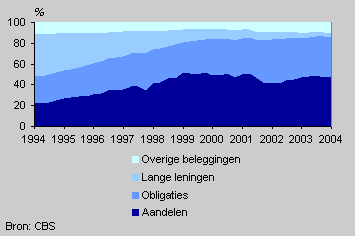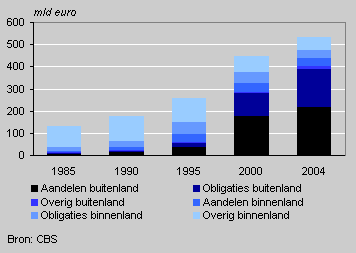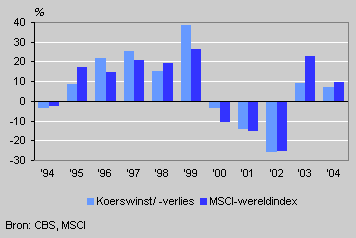Pension reserves increasingly invested in securities

At the end of 2004 pension funds in the Netherlands had invested more than 252 billion euro in shares and more than 205 billion euro in bonds. These securities thus accounted for 86 percent of the total 533 billion of pensions funds’ invested capital.
Structure of investment portfolio, 31 December

More shares and bonds
At the end of 1994 only 49 percent of capital invested by pension funds consisted of securities, of which 23 percent was in shares and 26 percent in bonds. Investment in shares has since risen, to 47 percent at the end of 2004. This increase took place entirely in the nineties, partly as a consequence of rising share prices. At the end of 1999, 52 percent of pension funds’ investment was in shares. Investment in bonds rose from 26 to 39 percent in the period 1994–2004. Opposite this substantial increase in investment in securities, pension funds’ investment in long-term loans decreased, from 41 percent of their capital in 1994 to 4 percent in 2004.
Investment by pension funds at home and abroad, 31 December

Investment abroad
The increase of securities in the overall portfolio went hand in hand with a strong internationalisation of investment. At the end of 1985 pension funds had invested nearly 8 billion euro in foreign securities, 6 percent of the total invested capital. At the end of 2004 this had risen to 388 billion euro, or nearly 73 percent of total capital.
Spreading investment
The internationalisation of pension funds’ investment is based on various factors. There are more opportunities abroad to invest in other currencies, countries and sectors of industry. This means pensions funds can spread their risk and there are more opportunities to invest where they expect to realise the highest return. The introduction of the euro also played a part, especially in bond investment, as investment within the euro area is no longer exposed to risks connected with exchange rates. At the end of 2004 66 percent of foreign bonds owned were held in the euro area. For foreign shares this was 23 percent.
Share profits
The return on share investment depends on stock market developments. Following the stock market boom in the nineties, share prices fell in the first three years of the new millennium. In 2003 and 2004 they have started to rise again. In the period 1994–2004 some 62 billion euro profit was made on share investments. This is an average of 7 percent a year, and about the same as the average increase in the MSCI world index for shares.
Share profits and losses: pension funds and MSCI world index

Bart van Wezel